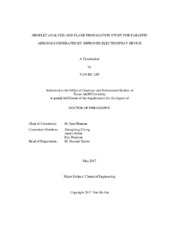| dc.description.abstract | Throughout the process industries, there have been numerous fire and explosion incidents related to aerosols. Aerosols may form from rapid condensation of vapor or accidental leakage of pressurized liquid. However, their hazards are relatively unfocused and the data pertinent to aerosols are scarce compared to vapor and dust. In this research, the electrospray system used to generate aerosol was improved, and the major controlling parameters which affect aerosol quality were studied. Finally, the flame speed of aerosol was researched based on the improvement and findings of stable operation parameters.
The main objective of this study was to advance the understanding of aerosol flame propagation behavior, which provides insight regarding reaction kinetics and pressure rise per unit time. This was made possible by modifying a previous electrospray device. The electrospray was improved by redesigning the whole system. The nozzle packing density was increased by five times, and the electrical force on each nozzle was more uniform. The concentration of aerosol was further promoted by applying a flat grounded mesh and a cylindrical grounded mesh.
The operating parameters of electrospray were also discussed, including additive, liquid flow rate and applied voltage. Amongst the four types of additives tested, Stadis 450 was the most effective one to facilitate the breakup of droplets. The amount of additive also affected the droplet size distribution. Therefore, the type and amount of additive should be selected carefully to reach the balance of small droplet size and uniform size distribution. This also applied to the liquid flow rate and voltage, and a stable operating region was proposed based on the liquid flow rate and voltage. Electrospray should be operated in this region to conduct consistent studies.
Enhanced aerosol flame speed was observed in a certain “transition droplet size range.” A theoretical calculation was provided to describe the aerosol flame propagation. Although it failed to predict the location of transition range, the estimation of flame speed was improved. An empirical analysis was also proposed to correlate the relationship between the aerosol flame speed, droplet size and liquid properties. The fitting to the experimental results was fairly successful, which indicates the proposed relationship can be considered to further improve the theoretical models. | en |


